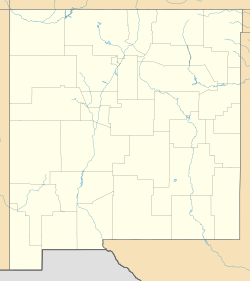White Oaks, New Mexico facts for kids
|
White Oaks Historic District
|
|

Old commercial building in White Oaks
|
|
| Location | 12 mi. NE of Carrizozo, on NM 349 |
|---|---|
| Area | 1,822.5 acres (737.5 ha) |
| Built | 1879 |
| NRHP reference No. | 70000403 |
Quick facts for kids Significant dates |
|
| Added to NRHP | September 4, 1970 |
White Oaks is a fascinating ghost town in Lincoln County, New Mexico, United States. It sits near the Lincoln National Forest. This area became a very busy "boomtown" in 1879. This happened after people found lots of gold and coal in the nearby Jicarilla Mountains.
Contents
History of White Oaks
Early Days and Gold Discovery
Before White Oaks became a lively town, the area was home to the Piros Indians. They were later moved out by the Apache people. These Native American groups found many animals here, making it a great hunting spot.
The first Europeans to explore this land were part of Don Juan de Onate's group in the late 1500s. They called the land "Malpais" because of a nearby lava flow.
Later, a man named John J. Baxter heard stories about gold in the area. He was a prospector who had been disappointed in California. He followed local Mexican prospectors to a small canyon. There, they found what became known as the Homestake mine.
The Boomtown Begins
News of the gold spread quickly. Within a year, a new mining camp appeared, full of tents. People named the camp White Oaks. This was because a small stream nearby was lined with white oak trees.
In 1880, a post office opened. Soon, permanent buildings replaced the tents. The town grew fast, with about 50 different businesses. These included four newspapers, two hotels, three churches, and a bank. There was also an opera house and places for entertainment.
Miners Winters and Baxter started the Homestake Mine and the South Homestake Mine. The mountain where the gold was found was named Baxter Mountain. Eventually, these two miners sold their claims for a lot of money.
Famous Visitors and Town Life
Many well-known people from the American Old West visited White Oaks. These included Dave Rudabaugh, Billy the Kid, Pat Garrett, and Shotgun John Collins.
Jonathan H. Wise started the town's first newspaper in 1880. It was called the White Oaks Golden Era. Other newspapers included the Lincoln County Leader and the Old Abe Eagle.
In November 1880, a group of lawmen from White Oaks chased Billy the Kid. During a tense situation, Deputy Sheriff Jim Carlyle was shot. It is still not fully known who shot him. Billy the Kid managed to escape.
Billy the Kid later wrote a letter to Governor Lew Wallace. He explained his side of the story about Deputy Carlyle's death. He said that lawmen had surrounded the house where he was. He claimed that Deputy Carlyle entered without a warrant. Billy said he told Carlyle he would have to stay inside until morning. A shot was fired, and Carlyle jumped from a window. He was then shot, possibly by his own group. The identity of the shooter is still not confirmed.
Growth and Decline
By July 1880, White Oaks had 800 people. Its population later reached 4,000. In 1882, Starr's Opera House was finished. The town also had several stores, a school, and a town hall. In 1884, the first church services were held in a proper church building.
By 1885, White Oaks was doing well. Many professionals, like attorneys, opened businesses there. However, the town's future depended on a railroad coming through. In the late 1890s, two railroad companies planned to extend tracks toward White Oaks.
Local businesses in White Oaks did not want to make deals to bring the railroad to town. They tried to charge very high prices for land. They thought the railroads would compete for the chance to come to White Oaks. But this plan did not work.
Instead, the railroad chose to build its tracks twelve miles west, through Carrizozo, New Mexico. By the late 1890s, the gold mines were running out. The town's population began to shrink. Also, many business disagreements caused problems. By the early 1900s, White Oaks was a shadow of its former self.
Notable Residents and Today
Susan McSween Barber was the widow of Alexander McSween. He was killed during the Lincoln County War. She became known as the "Cattle Queen of New Mexico." She bought and developed the Three Rivers Ranch. She eventually owned over 5,000 cattle. In 1902, she sold her ranch and moved to White Oaks. She lived there until she died in 1931. She is buried in the old White Oaks cemetery.
Another important person buried there is former New Mexico state Governor William McDonald. He was the state's first governor after New Mexico became a state. He had also been a local attorney and president of the Exchange Bank of White Oaks.
In 1970, White Oaks was added to the National Register of Historic Places. It was recognized as a historic district. By then, not much of the original town remained. Even though the district covered a large area, only six buildings were still historically important.
Today, one of the old entertainment spots, The No Scum Allowed Saloon, is still open.



